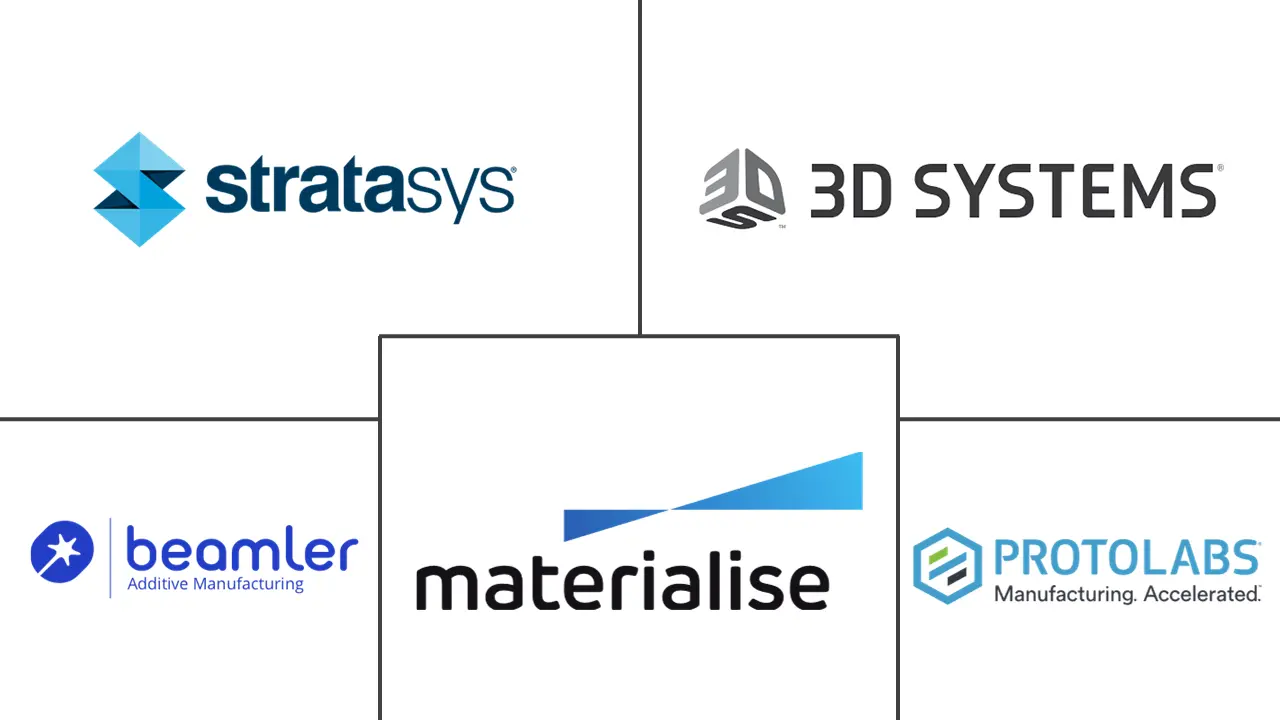Material Jetting Process 3D Printing Market Size and Share
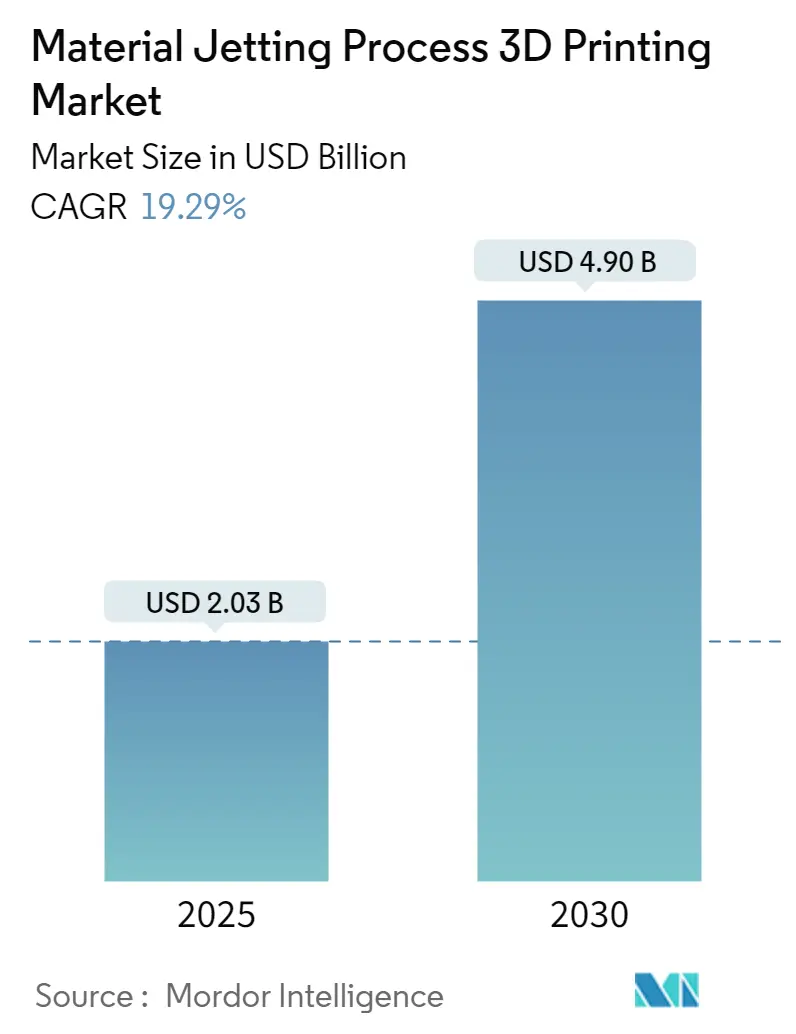
Material Jetting Process 3D Printing Market Analysis by Mordor Intelligence
The Material Jetting Process 3D Printing Market size is estimated at USD 2.03 billion in 2025, and is expected to reach USD 4.90 billion by 2030, at a CAGR of 19.29% during the forecast period (2025-2030).
- Material jetting's ability to simultaneously print in various materials and colors is a key driver of its growth. This capability is particularly beneficial for jewelry, automotive, and healthcare sectors, which require detailed, functional prototypes with specific material properties and color nuances.
- Material jetting's ability to produce full-colour parts makes it an excellent choice for prototyping. It is carving out a significant niche in creating medical models and visual support for training medical personnel. For instance, patient MRI or CT scan data can be seamlessly transformed into a 3D point cloud. This can then be printed in color, featuring varied textures and material properties, aiding doctors in planning intricate surgeries and medical procedures. Additionally, the capability to print multiple materials in one pass reduces manufacturing time and conserves resources, driving its growing adoption.
- The healthcare sector increasingly leverages material jetting for applications, including custom implants, prosthetics, dental devices, and anatomical models. Due to its fine resolution and biocompatible material options, the technology facilitates highly tailored medical solutions crucial for patient-specific treatments.
- Leading 3D printing manufacturers are making significant advancements, utilizing 3D printing technology to produce medical solutions like dentures and securing government approvals. For example, in September 2024, 3D Systems' denture solution, crafted using their jetting technology and NextDent materials, received FDA 510k clearance. This single-piece denture boasts durability, longevity, and realistic aesthetics.
- The material jetting market is witnessing accelerated growth due to the broader adoption of digital manufacturing techniques. The integration of automation and artificial intelligence into material jetting systems aims to optimize part design, minimize material waste, and boost overall efficiency. Such advancements are prompting manufacturers to view 3D printing as a primary production method, moving beyond its traditional role in prototyping.
- However, high material costs, especially for photopolymers, pose a significant hurdle to the widespread adoption of material jetting. Coupled with the steep prices of the machines themselves, this financial barrier makes it challenging for SMEs to invest in the technology. Consequently, the market is predominantly driven by large corporations in high-value sectors like aerospace and healthcare. Additional challenges encompass post-processing requirements and slow printing speeds.
- Material costs, influenced by inflationary pressures, have affected the market dynamics. Yet, despite economic uncertainties, sectors like aerospace, automotive, and healthcare persist in their investments in advanced manufacturing technologies. These industries acknowledge the long-term advantages of customization, shortened lead times, and sustainable production, leading to sustained R&D investments even amidst macroeconomic turbulence.
Global Material Jetting Process 3D Printing Market Trends and Insights
Healthcare Sector is Experiencing Growth in Demand
- Healthcare providers are increasingly turning to material jetting for applications such as custom prosthetics and implants, driven by the rising demand for patient-specific medical devices. The precision of material jetting enables exact replications of a patient's anatomy, a factor crucial for enhancing surgical outcomes.
- Healthcare professionals are using 3D-printed surgical guides and anatomical models for pre-surgical planning. These models not only facilitate practice on complex procedures, reducing surgery times and enhancing accuracy, but they also allow for the creation of tailor-made anatomical models directly from the patient's CT scan, enhancing the surgeon's visualization and training.
- MedScan3D is among the companies leading the design of these models. Their diverse range of 3D-printed products enhances surgical procedures and serves as educational tools for healthcare professionals and aspiring doctors. A survey conducted by Future Medicine in 2023 involving 50 seasoned surgeons revealed that a significant 94% found 3D-printed models invaluable for pre-surgical planning.
- Material jetting is emerging as the go-to method for crafting custom dental implants, crowns, and bridges. By leveraging this technique, multi-material, high-resolution dental device production becomes more efficient, significantly reducing time and costs compared to traditional methods. Leading the charge in this transformation, Stratasys unveils its advanced multi-material jetting 3D printing solutions, leveraging its proprietary PolyJet technology. This innovation enables dental labs to concurrently craft a diverse array of biocompatible dental applications, lifelike full-color dental models, and intricate multicolored dental appliances.
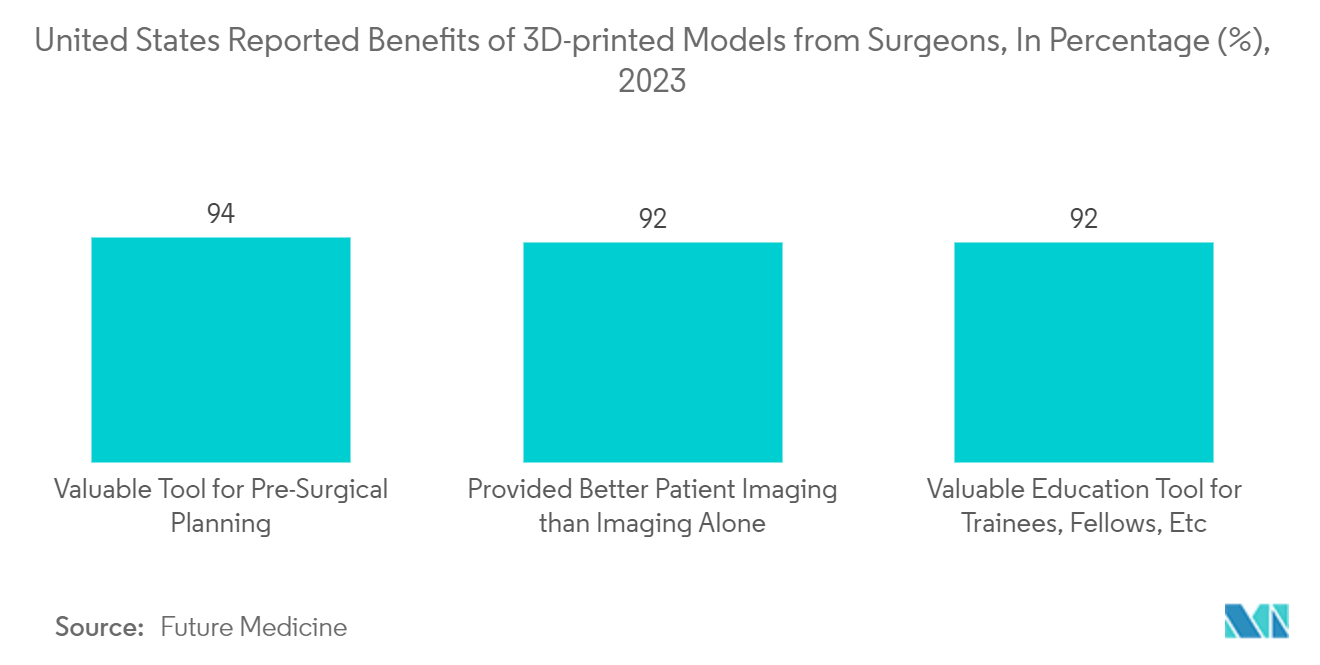
North America Holds Significant Market Share
- North America's strong aerospace and automotive sectors play a pivotal role in driving the material jetting market. Notably, the US aerospace industry is making significant investments in 3D printing technologies, aiming to bolster supply chain resilience and shorten component production lead times, positioning it as a key growth area.
- For example, in March 2024, GE Aerospace unveiled a USD 650 million investment plan for its manufacturing facilities and supply chain, targeting enhanced production and quality support for both commercial and defense clients. Out of this, USD 54 million is allocated for new 3D printing machines and tooling to boost production for military rotorcraft engine components and engines for commercial aircraft, creating a favorable ecosystem for the studied market's growth.
- The healthcare sector in North America, especially in the US, is swiftly embracing 3D printing for crafting custom medical devices, anatomical models, prosthetics, and more. Collaborations among manufacturers and industry players are on the rise, aiming to elevate offerings in the healthcare domain. For instance, in November 2023, Ricoh USA Inc. forged a partnership with Materialise, set to deliver software solutions bolstering RICOH 3D for healthcare. This center, certified for 3D medical manufacturing, specializes in designing and producing 3D-printed anatomic models.
- Several studies and research work being done in the region continue to highlight the benefits of material jetting technology, encouraging users across different sectors to opt for this technology. For instance, in 2023, the Additive Manufacturer Green Trade Association, a global advocacy group (based in Florida), was dedicated to championing sustainable practices in the additive manufacturing (AM) industry. Recently unveiled findings from a life-cycle inventory (LCI) study titled “Comparative Analysis: 3D Material Jetting vs Traditional Methods for Designer Luxury Goods.” The study revealed a significant 24.8% decrease in CO2-eq emissions and a notable 49.9% cut in stock material usage throughout the supply chain, especially when juxtaposed with traditional methods.
- Furthermore, leading the globe in R&D investments for additive manufacturing technologies, including material jetting, North America boasts prominent research institutions, universities, private enterprises, and startups dedicated to advancing material jetting processes. A case in point: in March 2024, U.S.-based startup Fluent Metal Inc. secured USD 5.5 million in venture capital to focus on developing and commercializing its drop-on-demand technology, a material jetting technology.
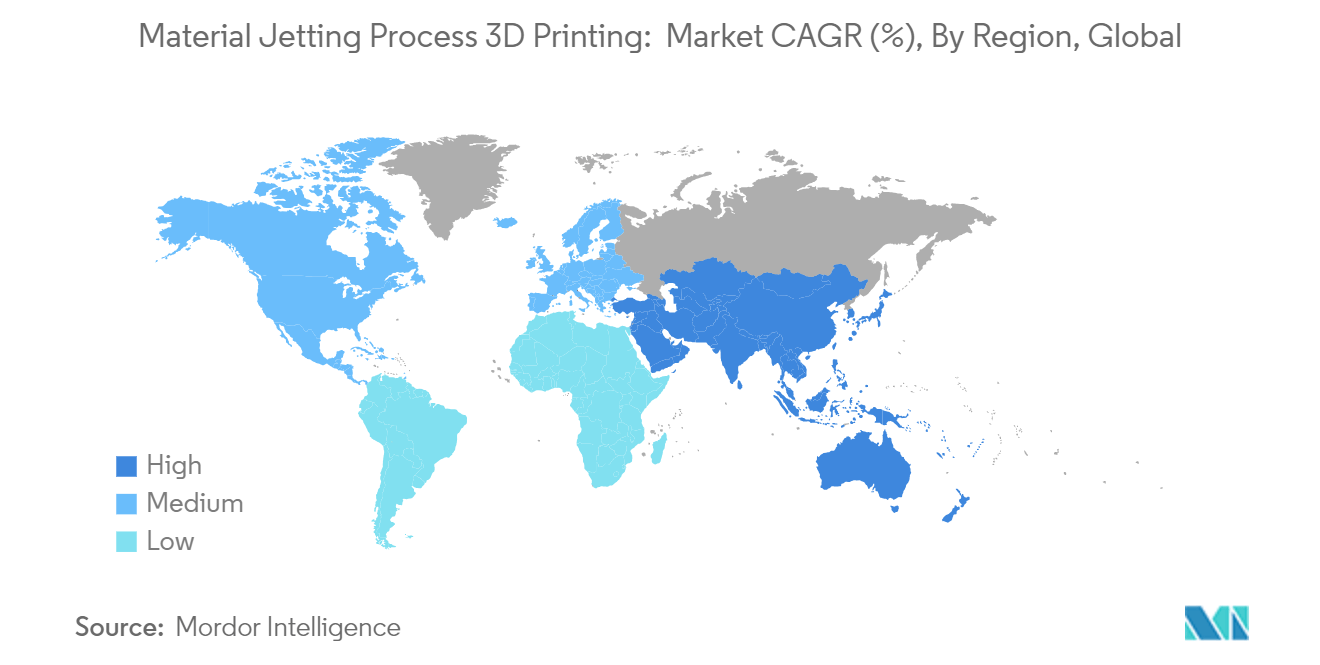
Competitive Landscape
The market boasts a competitive landscape featuring a mix of established global 3D printing giants and nimble startups. Technological innovations, strategic collaborations, acquisitions, and an ever-expanding product portfolio fuel growth in the market.
Leading the material jetting market are several major companies. These industry frontrunners have harnessed advanced technologies, broadened their horizons through strategic acquisitions, and forged robust partnerships across various sectors. Stratasys Ltd, 3D Systems Corporation, HP Inc., and Mimaki Engineering Co. Ltd are notable players.
Numerous companies prioritize strategic partnerships and collaborations with pivotal industry players and research institutions to maintain their edge. These alliances focus on product development, broadening material portfolios, and enhancing the capabilities of material jetting technologies. Furthermore, companies are channeling significant investments into R&D to boost material jetting precision, widen the spectrum of printable materials, and curtail production costs.
Material Jetting Process 3D Printing Industry Leaders
-
Stratasys Ltd.
-
3D Systems Corporation
-
Voxeljet AG
-
Materialise NV
-
Beamler
- *Disclaimer: Major Players sorted in no particular order
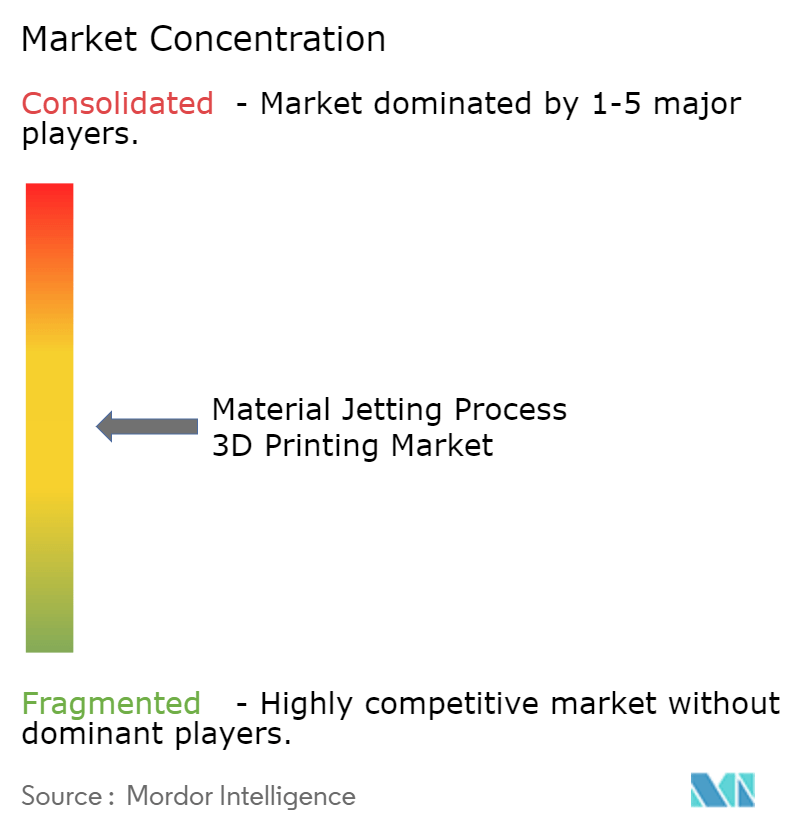
Recent Industry Developments
- February 2024: 3D Systems, a US-based manufacturer of 3D printers, has unveiled its latest offering: a multi-material 3D printed denture. This innovation is touted as the industry's inaugural solution for multi-material, jetted, and monolithic (one-piece) 3D-printed dentures. The NextDent Jet Denture Teeth from 3D Systems replicate the rigidity and aesthetics of natural teeth, while the NextDent Jet Denture Base is designed to absorb impact and boasts remarkable break resistance, ensuring comfort and flexibility.
- February 2024: Quantica has teamed up with ImageXpert to deliver an advanced solution for material jetting. The collaboration, inked with ImageXpert—renowned for its robust machine-vision-based measurement systems—centers on several pivotal areas: First, enhancing Quantica’s NovoJet Printhead Technology to process new materials for both 2D and 3D manufacturing. Second, integrating Quantica’s JetPack with ImageXpert’s JetXpert systems. The JetPack is crucial for validating and optimizing new materials with NovoJet printheads, leveraging real-time drop shape, volume, and velocity analysis through the JetXpert Dropwatcher.
Global Material Jetting Process 3D Printing Market Report Scope
Material Jetting 3D printing is an additive manufacturing process in which droplets of liquid material, typically photopolymers, waxes, or metals, are precisely jetted into a build platform layer by layer. Each layer is often solidified through UV light or cooling to create highly detailed and smooth parts. Material jetting allows for the simultaneous use of multiple materials and colors, enabling the creation of complex, multi-material objects with fine resolutions.
The study tracks the revenue generated from selling material jetting 3D printers, materials, and related services by various manufacturers and service providers worldwide. It also tracks the key market parameters, underlying growth influencers, and major manufacturers operating in the industry, which supports the market estimations and growth rates over the forecast period. The study further analyses the overall impact of macroeconomic factors on the market. The report’s scope encompasses market sizing and forecasts for the various market segments.
The material jetting 3D printing market is segmented by component (hardware, material, and services), type (poly jet, nanoparticle jetting (NPJ), and drop on demand (DoD)), end-user vertical (aerospace and defense, automotive, medical, and Other end-user verticals), and geography (North America, Europe, Asia-Pacific, Latin America, and Middle East and Africa). The market sizes and forecasts are provided in terms of value (USD) for all the above segments.
| Hardware |
| Material |
| Services |
| Polyjet |
| Nanoparticle Jetting (NPJ) |
| Drop on Demand (DoD) |
| Aerospace and Defense |
| Automotive |
| Medical |
| Other end-users Vertical |
| North America |
| Europe |
| Asia |
| Australia and New Zealand |
| Latin America |
| Middle East and Africa |
| By Component | Hardware |
| Material | |
| Services | |
| By Type | Polyjet |
| Nanoparticle Jetting (NPJ) | |
| Drop on Demand (DoD) | |
| By End User Vertical | Aerospace and Defense |
| Automotive | |
| Medical | |
| Other end-users Vertical | |
| By Geography*** | North America |
| Europe | |
| Asia | |
| Australia and New Zealand | |
| Latin America | |
| Middle East and Africa |
Key Questions Answered in the Report
How big is the Material Jetting Process 3D Printing Market?
The Material Jetting Process 3D Printing Market size is expected to reach USD 2.03 billion in 2025 and grow at a CAGR of 19.29% to reach USD 4.90 billion by 2030.
What is the current Material Jetting Process 3D Printing Market size?
In 2025, the Material Jetting Process 3D Printing Market size is expected to reach USD 2.03 billion.
Who are the key players in Material Jetting Process 3D Printing Market?
Stratasys Ltd., 3D Systems Corporation, Voxeljet AG, Materialise NV and Beamler are the major companies operating in the Material Jetting Process 3D Printing Market.
Which is the fastest growing region in Material Jetting Process 3D Printing Market?
Asia Pacific is estimated to grow at the highest CAGR over the forecast period (2025-2030).
Which region has the biggest share in Material Jetting Process 3D Printing Market?
In 2025, the North America accounts for the largest market share in Material Jetting Process 3D Printing Market.
What years does this Material Jetting Process 3D Printing Market cover, and what was the market size in 2024?
In 2024, the Material Jetting Process 3D Printing Market size was estimated at USD 1.64 billion. The report covers the Material Jetting Process 3D Printing Market historical market size for years: 2019, 2020, 2021, 2022, 2023 and 2024. The report also forecasts the Material Jetting Process 3D Printing Market size for years: 2025, 2026, 2027, 2028, 2029 and 2030.
Page last updated on:
Material Jetting Process 3D Printing Market Report
Statistics for the 2025 Material Jetting Process 3D Printing market share, size and revenue growth rate, created by Mordor Intelligence™ Industry Reports. Material Jetting Process 3D Printing analysis includes a market forecast outlook for 2025 to 2030 and historical overview. Get a sample of this industry analysis as a free report PDF download.
